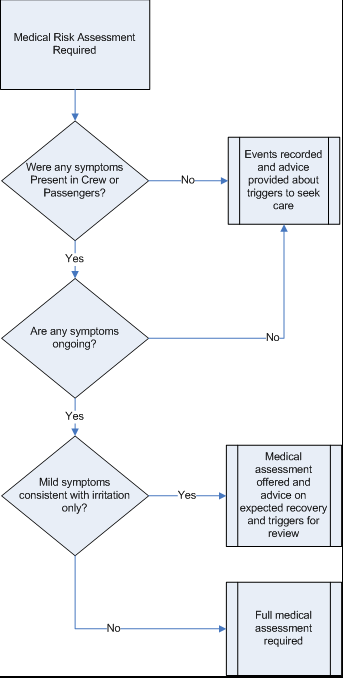

Smoke and fume / smell events – usually referred to as ‘cabin air contamination’ – have recently been highlighted as a potential threat to air safety and awareness of the inherent risk of such events has been growing. Studies and occurrence / accident reports have shown that such events could pose a threat to the safety of flight operations as well as to the health of cockpit / cabin crew and passengers. Reporting of such events is of great importance to gather reliable data on the phenomenon and hopefully reduce the risk of smoke and fume / smell events in the future.
Against this background ECA introduces guidelines on how to deal with fume / smell events. The aim is to ensure that such events are correctly recognized by air crew, are adequately dealt with during flight operations, and are followed-up upon, including through proper reporting to the company / authority.
The primary aim of occurrence reporting in aviation is for organizational learning. By proper reporting, each crew member makes sure that operators manufacturers and authorities have access to the best available information from the flight and cabin crew.
The ECA Task Group on Cabin Air Quality introduces these guidelines with the intention to give each ECA Member Association the opportunity to adapt them to their needs and local procedures and to thereby enhance the flight crews’ reporting of these events.
Smoke. The product of burning materials made visible by the presence of small particles.
Fume(s). Odorous, gaseous compounds which are not visible.
Note. — In the context of the ICAO circular, fumes and odours are deemed to be synonymous, and the term “fume(s)” includes both fumes and odours.
Contaminant. An airborne constituent that may reduce air quality.
The symptoms associated with cabin air contamination are diverse, but nervous and respiratory symptoms prevail.
List of possible symptoms:

Note: these symptoms are given as examples, and may not necessarily mean you suffer(ed) from a fume / smell intoxication. These symptoms can also be provoked by other factors. However, when several of these symptoms occur (in combination) within a short time frame and are of a pronounced nature, they deserve particular attention.
How to react during & after flight operations?
> Apply QRH « Smoke/Fumes » checklist.
> Record symptoms (cockpit/cabin crew as well as passengers if possible or convenient)
> Inform airline (Maintenance, Dispatch or Operations)
> Perform a Tech Log Entry
> Fill in an occurrence report in line with company regulations and EU376/2014 as required
> Fill in the Smoke and Smell Report (See ICAO Circular 344, Appendix to Chapter 4 “Standardized Smoke / Fumes Reporting Form)
> Debrief with the whole crew
> In case of symptoms/health problems:
> File an occupational health and safety report, as applicable.
Note 1: Make sure to explain to your members the differences between an Occurrence Report and an Occupational Health and Safety Report.
Note 2: ICAO circular 344-AN/202 is a guideline to States to support the development of relevant advisory material for operators to provide suitable awareness and/or training to flight crew, cabin crew and AMT to enable them to prevent, recognize and respond to the presence of fumes, particularly aircraft air supply system-sourced engine or auxiliary power unit (APU) oil or hydraulic fluid fumes. It does not address on-board exposure to smoke or fire. This circular is not only aimed at educating flight crews, but is also meant to train aircraft maintenance technicians and management personnel. Ask a copy from this circular to your operator and request the operator’s gap analysis and implementation into the SMS system, as required by this circular.
Note 3:
EU Reg. 376/2014 on Occurrences in civil aviation — reporting, analysis and follow-up (For a summary, the Regulation’s text and related ‘Implementing Regulation’ with the list of occurrences: see here).
Implementing Regulation 2015/1018: Annex I, Section 2 (4)
Implementing regulation contains:
2. TECHNICAL OCCURRENCES
(4) Leakage of any fluid which resulted in a fire hazard or possible hazardous contamination of aircraft structure, systems or equipment, or which has or could have endangered the aircraft, its occupants or any other person.
4. EMERGENCIES AND OTHER CRITICAL SITUATIONS
(1) Any event leading to the declaration of an emergency (‘Mayday’ or ‘PAN call’)
(2) Any burning, melting, smoke, fumes, arcing, overheating, fire or explosion.
(3) Contaminated air in the cockpit or in the passenger compartment which has or could have endangered the aircraft, its occupants or any other person.
(9) Any use of crew oxygen system by the crew.
(10) Incapacitation of any member of the flight or cabin crew that results in the reduction below the minimum certified crew complement.
Scientific research in the field of Cabin Air Quality is still ongoing, and the types of tests that would need to be performed routinely after a fume event have not been established yet. Therefore, only general guidelines on what medical tests should be performed can be given.
Some airlines have their own medical procedure in case of fume / smell events and these should be followed if your airline has such a procedure. In addition, different tests can be performed as part of research purposes depending where the medical examination takes place.
In any case:
(Graphic: IATA)

Medical Self assessment checklist*
The examination should include (refer to IATA Guidance for airline health and safety staff on the medical response to Cabin Air Quality events, Chap. 8 for more details):
O2-Saturation and arterial blood gas analysis (PaO2, PaCO2, Ph, HCO3-)
Hemoglobin, methemoglobin, carboxyhemoglobin
Blood-glucose, lactate, electrolytes
* Source: IATA Guidance for airline health & safety staff on the medical response to Cabin Air Quality events
ICAO Circular 344 “Guidelines on Education Training and Reporting Practices related to Fume Events”
IATA Guidance for airline health and safety staff on the medical response to Cabin Air Quality events.